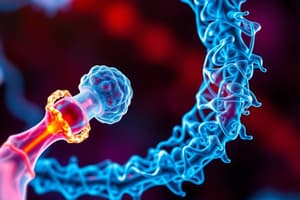Podcast
Questions and Answers
What is produced as a byproduct of anaerobic respiration in humans?
What is produced as a byproduct of anaerobic respiration in humans?
- Carbon Dioxide
- Lactic Acid (correct)
- Ethanol
- Oxygen
Which of the following statements about aerobic respiration is true?
Which of the following statements about aerobic respiration is true?
- It occurs only in prokaryotic cells.
- It produces lactic acid as a byproduct.
- It requires oxygen to proceed. (correct)
- It takes place only in the cytoplasm.
What is the total ATP yield from anaerobic respiration?
What is the total ATP yield from anaerobic respiration?
- 12 ATP
- 2 ATP (correct)
- 4 ATP
- 38 ATP
Which of the following products is generated during anaerobic respiration in yeast?
Which of the following products is generated during anaerobic respiration in yeast?
Where does anaerobic respiration occur within a cell?
Where does anaerobic respiration occur within a cell?
Which of the following accurately describes aerobic respiration?
Which of the following accurately describes aerobic respiration?
What are the reactants needed for anaerobic respiration in humans?
What are the reactants needed for anaerobic respiration in humans?
What is the primary purpose of cellular respiration?
What is the primary purpose of cellular respiration?
Which of the following best explains aerobic respiration?
Which of the following best explains aerobic respiration?
Which of the following statements is true regarding aerobic and anaerobic respiration?
Which of the following statements is true regarding aerobic and anaerobic respiration?
What gas is a byproduct of cellular respiration?
What gas is a byproduct of cellular respiration?
Which of the following is a reactant in the process of photosynthesis?
Which of the following is a reactant in the process of photosynthesis?
During which part of cellular respiration is ATP primarily produced?
During which part of cellular respiration is ATP primarily produced?
What is the fate of glucose in cellular respiration?
What is the fate of glucose in cellular respiration?
Which component in plant cells is primarily responsible for photosynthesis?
Which component in plant cells is primarily responsible for photosynthesis?
Why is cellular respiration critical for living organisms?
Why is cellular respiration critical for living organisms?
What happens to the dough as it bakes in the warm oven?
What happens to the dough as it bakes in the warm oven?
Which of the following processes is NOT part of cellular respiration?
Which of the following processes is NOT part of cellular respiration?
In which condition does anaerobic respiration primarily occur?
In which condition does anaerobic respiration primarily occur?
Why is cellular respiration considered essential for living organisms?
Why is cellular respiration considered essential for living organisms?
Which component is NOT a part of the photosynthesis equation?
Which component is NOT a part of the photosynthesis equation?
What is the primary function of the chloroplasts in plant cells?
What is the primary function of the chloroplasts in plant cells?
Which statement best describes aerobic respiration?
Which statement best describes aerobic respiration?
How does exercise intensity affect cellular respiration?
How does exercise intensity affect cellular respiration?
What is the role of chlorophyll in photosynthesis?
What is the role of chlorophyll in photosynthesis?
Which process occurs when the plant takes in carbon dioxide and releases oxygen?
Which process occurs when the plant takes in carbon dioxide and releases oxygen?
What is produced as a result of splitting water in photosynthesis?
What is produced as a result of splitting water in photosynthesis?
Where does photosynthesis primarily occur in plants?
Where does photosynthesis primarily occur in plants?
What do thylakoids in chloroplasts represent?
What do thylakoids in chloroplasts represent?
What key substances are used by plants to produce sugars during photosynthesis?
What key substances are used by plants to produce sugars during photosynthesis?
Why is photosynthesis considered important for the environment?
Why is photosynthesis considered important for the environment?
What are the final products of photosynthesis?
What are the final products of photosynthesis?
What is the primary product of cellular respiration?
What is the primary product of cellular respiration?
Where does anaerobic respiration primarily take place?
Where does anaerobic respiration primarily take place?
Which of the following statements about ATP production is accurate?
Which of the following statements about ATP production is accurate?
What is produced as a waste product during anaerobic respiration?
What is produced as a waste product during anaerobic respiration?
What occurs during the glycolysis stage of cellular respiration?
What occurs during the glycolysis stage of cellular respiration?
In what type of respiration is glucose oxidized to release energy?
In what type of respiration is glucose oxidized to release energy?
Which statement best describes the efficiency of anaerobic respiration compared to aerobic respiration?
Which statement best describes the efficiency of anaerobic respiration compared to aerobic respiration?
Which energy carriers are involved in cellular respiration?
Which energy carriers are involved in cellular respiration?
Flashcards are hidden until you start studying
Study Notes
Cellular Respiration
- Living organisms require energy to function, even at a microscopic level.
- Cellular respiration is the process that converts chemical energy stored in organic molecules (like glucose) into energy that cells can use, called Adenosine Triphosphate (ATP).
- Reactants of cellular respiration: glucose (C6H12O6) and oxygen (O2)
- Product of cellular respiration: carbon dioxide (CO2), water (H2O), and energy (ATP)
- Cellular respiration occurs in three stages:
- Glycolysis: occurs in the cytoplasm, splitting glucose into two pyruvate molecules and producing 2 net ATP, 2 NADH, and 2 pyruvate acids. This stage can happen with or without oxygen (aerobic or anaerobic).
- Krebs Cycle (Citric Acid Cycle): occurs in the matrix of mitochondria, further breaking down pyruvate and producing 2 net ATP, 6 CO2, 8 NADH, and 2 FADH2. This stage requires oxygen.
- Electron Transport Chain: occurs in the inner membrane of mitochondria, generating the majority of ATP (34 ATP). This stage requires oxygen.
- ATP is the primary energy currency of the cell, used to power essential cellular processes.
- Energy carriers involved in cellular respiration:
- Adenosine Triphosphate (ATP)
- Nicotinamide Adenine Dinucleotide (NAD)
- Flavin Adenine Dinucleotide (FAD)
Types of Cellular Respiration
- Aerobic Respiration: requires oxygen to break down glucose, creating a large amount of ATP (38 ATP).
- Equation: Glucose + Oxygen → Carbon Dioxide + Water + Energy
- Anaerobic Respiration: occurs in the absence of oxygen, less efficient, producing a small amount of ATP (2 ATP).
- Equation (Muscles): Glucose → Lactic Acid + Energy
- Equation (Yeast): Glucose → Ethanol + Carbon Dioxide + Energy
- Key differences between aerobic and anaerobic respiration:
- Oxygen requirement: Aerobic requires oxygen, anaerobic does not.
- Location: Aerobic occurs in cytoplasm and mitochondria, anaerobic primarily in cytoplasm.
- Efficiency: Aerobic is more efficient (38 ATP), anaerobic is less efficient (2 ATP).
- Products: Aerobic produces CO2 and H2O, anaerobic produces lactic acid (animals) or ethanol and CO2 (yeast).
Photosynthesis
- Photosynthesis is the process that converts light energy into chemical energy (sugars), used by living organisms.
- Occurs in plants and some algae.
- Three main events:
- Sunlight is converted into chemical energy.
- Water (H2O) is split into oxygen (O2).
- Carbon dioxide (CO2) is fixed into sugars (C6H12O6).
- Leaf structure: Chloroplasts contain chlorophyl, a green pigment that absorbs light energy for photosynthesis. Chloroplasts contain flattened discs called thylakoids, stacked into structures called grana. Stroma is the fluid inside the chloroplast.
- Process:
- Plants absorb water through roots.
- Leaves take in carbon dioxide from the air.
- Leaves capture light energy.
- Light energy is used to convert water and carbon dioxide into sugars and oxygen.
- Oxygen is released into the air.
- Plants use sugars for growth.
- Importance:
- Provides food source for many organisms.
- Provides energy for life processes.
- Maintains atmospheric CO2 levels and produces O2.
Importance of Cellular Respiration and Photosynthesis
- Cellular respiration provides energy for the function of all living organisms.
- Photosynthesis is crucial for the production of food, oxygen, and the regulation of atmospheric gases.
SDG Connections
- SDG 3: Good Health and Well-Being:
- Cellular respiration is fundamental for good health, providing energy for all bodily functions.
- SDG 13: Climate Action:
- Promoting photosynthesis, especially in urban environments, can contribute to reducing CO2 levels and mitigating climate change.
Studying That Suits You
Use AI to generate personalized quizzes and flashcards to suit your learning preferences.




